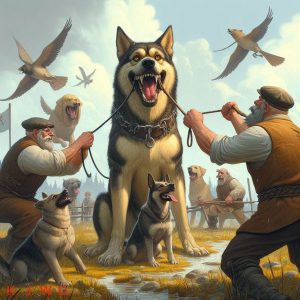The moral of the tale is that it is possible to have a perfectly behaved dog — just not one trained by anyone in my family.
Read More
My Grand-Dogs are Not Trained


The moral of the tale is that it is possible to have a perfectly behaved dog — just not one trained by anyone in my family.
Read More

Ah, pets. Those adorable bundles of fur, feathers, or scales that waddle or paddle into your life, demanding cuddles and causing chaos with equal enthusiasm. But let’s be honest folks, the whole “training pets” thing is a bit of a myth, isn’t it? More like a hilarious exercise in futility, orchestrated by our furry overlords.
Now, before the PETA brigade storms my comments section, let me clarify: I love animals. I truly do. But I also love truth, and the truth is, most of us are kidding ourselves when we think we are training our pets. We are more like their unpaid interns, fetching tennis balls, scooping up “presents,” and pretending their incessant barking and purring is actually a complex form of canine and feline communication.
Take my dog, Pete. A lovable slobbery doggy with the attention span of a goldfish on roller skates. We went through all the motions of puppy training classes: the clickers, the treats, the endless “sit!” commands that achieved precisely nothing except a confused look on Pete’s face and a perpetual state of drool on my carpet.
You see, Pete, like most pets, operates on his own internal logic. He learned “sit” eventually, but only because it meant I’d stop the annoying clicking noise. “Stay”? More like a vague suggestion, occasionally honored if the treat situation could be seen as favorable. As for “fetch”? Forget about it. Apparently, chasing squirrels and digging holes in the garden were far more life fulfilling activities.
And let’s not forget the emotional manipulation. Those puppy-dog eyes? A masterclass in guilt tripping. That mournful whine? An Oscar-worthy performance designed to extract belly rubs and extra Snausages. We, the supposedly dominant species, are putty in their paws, dancing to their silent, furry tune.
But hey, maybe that’s the beauty of it. We may not be training them, but they are certainly training us. Patience, resilience, and the ability to clean up unspeakable messes – these are the valuable life skills our pets so generously impart to us. Plus, who can resist a wet nose nuzzle or a pet cuddle after a long day?
So, the next time you think you are training your pet, take a step back and have a good laugh. You are not the alpha dog, you are the lovable dolt who gets tricked into belly rubs with only a sad whimper. Embrace the absurdity, folks. After all, isn’t that what life with pets is all about? A hilarious, heartwarming, and slightly chaotic adventure where the only real training happens to our sanity.
Now, if you’ll excuse me, Pete decided the living room rug is his new personal chew toy. Time to unleash the power of the clicker – again. Wish me luck!
–30–

I had one opportunity to spend a few days with my brother and some other road comics. The scene was southern California in the late 1980s. Hugh was working constantly--a lot of college campuses as well as comedy clubs.
Read More

Ashes and Stashes
When I retired after my long career as a librarian, I embarked on a new venture – helping people declutter and organize their stuff! (See Second Career – Home Organizer!)
I advertised my organizing services and I started getting calls from folks who said they needed help getting a handle on their paperwork; or their closets and drawers were a mess; or they were drowning in clutter; or were simply overwhelmed by too much stuff.
Those who I suspected were hoarders I referred to colleagues who had specialized training. Hoarding is a serious problem and in fact has been identified as a mental health condition.
But I was eager to help the garden variety clutterers, and I soon learned when folks let you into their homes and you earn their trust, they often share their secrets and their guilty pleasures. One client showed me where she kept her mother’s ashes, and an elderly woman I was helping pack for her move to an assisted living residence showed me her trove of love letters. They were from an old beau she had known 60 years ago, and she invited me to sit and listen as she lovingly read them aloud.
And then there was the guy whose studio apartment I was helping declutter who showed me where he kept a secret stash of his own.
That story I had to share with the press!
New York Times, Sept 18, 2023
– Dana Susan Lehrman